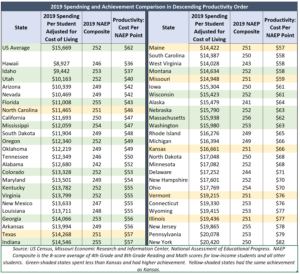Contrary to unsubstantiated claims by some education officials, Kansas has very low student achievement productivity, ranking #38 among the states. Education lobbyists insist that Kansas has very high achievement and gets more bang-for-the-buck than any high-achieving state, but the facts from the National Assessment of Educational Progress and the U.S. Census show differently.
 A dollar spent in Kansas buys a lot more than a dollar in New York or California. Kansas has the 2nd– lowest cost of living, according to the Missouri Economic Research and Information Center (MERIC). The state’s index of 86.8 means the cost of living in Kansas is 13.2% below the national average.
A dollar spent in Kansas buys a lot more than a dollar in New York or California. Kansas has the 2nd– lowest cost of living, according to the Missouri Economic Research and Information Center (MERIC). The state’s index of 86.8 means the cost of living in Kansas is 13.2% below the national average.
Adjusting spending for each state’s cost of living, Kansas spent $16,661 per student on a headcount basis in 2019; that’s 12% above the national average of $14,839. Kansas has the 6th-highest state aid per student, at $10,219…the 3rd-highest debt per student at $15,155…the 11th-highest cash per student…and the 4th-highest capital outlay per student at $2,229.
Low productivity in achievement
Kansas has high national rankings on spending but achievement on the National Assessment of Educational Progress – the gold standard of comparing states – is a little below average. Kansas’ composite score of 251 for the eight main measurements (4th grade and 8th grade reading and math for low-income students and everyone else); the national average is 252.
We can measure each state’s relative productivity – what some might call ‘bang for the buck’ – by dividing the NAEP score into per-student spending to find the cost per point scored. Analysis of this nature is needed to hold schools accountable for spending money in the most effective ways to close achievement gaps and get kids the education they deserve.
With COL-adjusted spending at $16,661 per student, Kansas is spending $66 per NAEP point. That’s worse than the national average of $59 per point and places Kansas at #38 on the productivity bang-for-the-buck ranking.

Once again, the data disproves the notion that spending more money is the key to having better achievement. Six other states have a 251 composite like Kansas, shaded yellow in the table above. North Carolina spent the least at $11,465 on an adjusted cost-of-living basis; Kansas spent $16,661 and Illinois spent the most, at $19,436. New York and California have the same score (250), but New York achieved it at $20,420 per student while California spent just $11,693. New York has the worst bang-for-the-buck at $84 per NAEP point.
Florida, on the other hand, is one of fifteen states (shaded green) that have a composite score higher than Kansas but spent less money per student on an adjusted cost-of-living basis.
The Kansas Association of School Boards may claim the state’s public school districts are in the top ten for achievement, but that’s never been true; Kansas’ NAEP rankings range from the high teens to the low 30s, and the 8-score composite is below average. ACT demographic scores are in the mid-30s, and both ACT and NAEP outcomes are declining.
Choice, transparency, and accountability give kids a fighting chance
The situation in Kansas will only get worse until parents put enough pressure on legislators to give kids a fighting chance with parental choice, transparency, and accountability. Florida did that beginning in 1998 and their low-income students went from about the worst in the nation to the best.

The way that many local school boards handled the COVID situation shows that improving student achievement is not their top priority. Change will only come when parental choice legislation gives every student below grade level an opportunity to take their funding to another school, and parents will have to help put pressure on the legislators who stand in the way.
The House passed that legislation this year by a 64-59 vote but the bill died in the Senate on a 20-20 tie. To overcome a guaranteed veto by Governor Kelly, 20 House members and seven senators from those listed below will need to change their vote.


Stay on top of education development, watch our documentary on creating education opportunities, and sign a petition to demand reform here.





